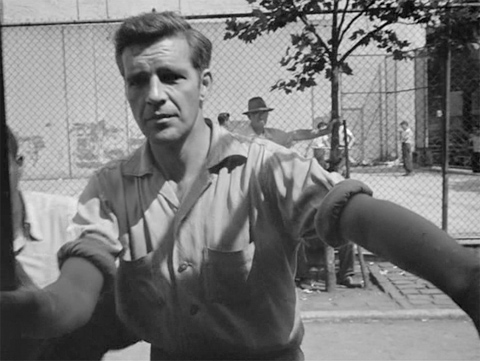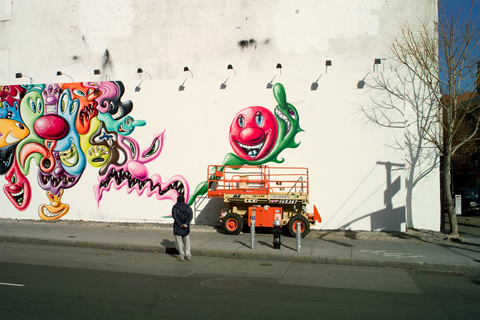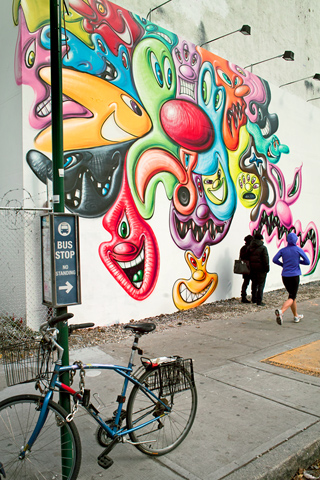
Houston Street and Bowery 1957 — from the film On the Bowery
In the previous post I wrote about seeing On the Bowery at Film Forum, and I connected several film locations with contemporary views of the same places. One of the spots that jumped out at me was the corner of Houston and Bowery where the protagonist in the story, Ray Salyer, goes in search of a day’s work. In the screen capture above, he walks up to the window of a truck–we see him from inside–and behind him is a chain link enclosed handball court with several people playing. That playground, and other open spaces along Houston, was created in the 1930s when the buildings on the north side of the street were demolished, displacing thousands of tenement dwellers, to allow for the digging of the IND subway line.
Watching the film, I suddenly realized that the wall in the rear is the same one that Keith Haring painted on in 1982, and which was used to recreate his mural in 2008. Many other graffiti artists have also worked on its surface. The original wall shown in On the Bowery is still there, but presently boxed in, now being used to showcase a changing array of artists.

Unfinished Kenny Scharf on the Houston/Bowery wall — © Brian Rose
The photo above was taken from approximately the same position as the scene in On the Bowery. But there is a major difference, and it took me a while to figure things out. In the film there is a broad sidewalk and full depth handball court on the north side of Houston. Today, as you can see above, a swath of sidewalk and about four feet of gravel is all that separates the street from the wall. What happened is that Houston Street was widened along the north side turning a four lane undivided street into the monster thoroughfare that it is today.
From the Times:
THE widening of the Houston Street roadbed, to two 45-foot-wide roadways separated by a narrow mall, did not start until 1957. The Times reported that ”new black-on-yellow street name signs will replace the outmoded blue-on-white signs,” referring to the old luminous enameled signs that occasionally show up on eBay. The new Houston Street, an eight-lane crosstown artery, was opened in 1963, just before the area south of Houston Street began to emerge as an artists’ enclave.

Unfinished Kenny Scharf on the Houston/Bowery wall
— © Brian Rose
Although the concrete handball court wall remains (a historic artifact encased in plywood), the Ray Salyers of the world no longer congregate at Houston and Bowery looking for work.
Pingback: *Everyday Chatter « NYC
That looks like the Thompson St Park between Prince and Spring Streets in Soho.
The scene in the movie takes place at Houston and Bowery. The men sit against the chain link fence of the handball court waiting for trucks to pull up looking for day laborers. In one view you can see the Cable Building in the distance at Broadway and Houston. The Third Avenue El is also visible, as well as the building that now houses the restaurant Pulino’s.
Pingback: Houston at Bowery: 5 Years | The Street Spot